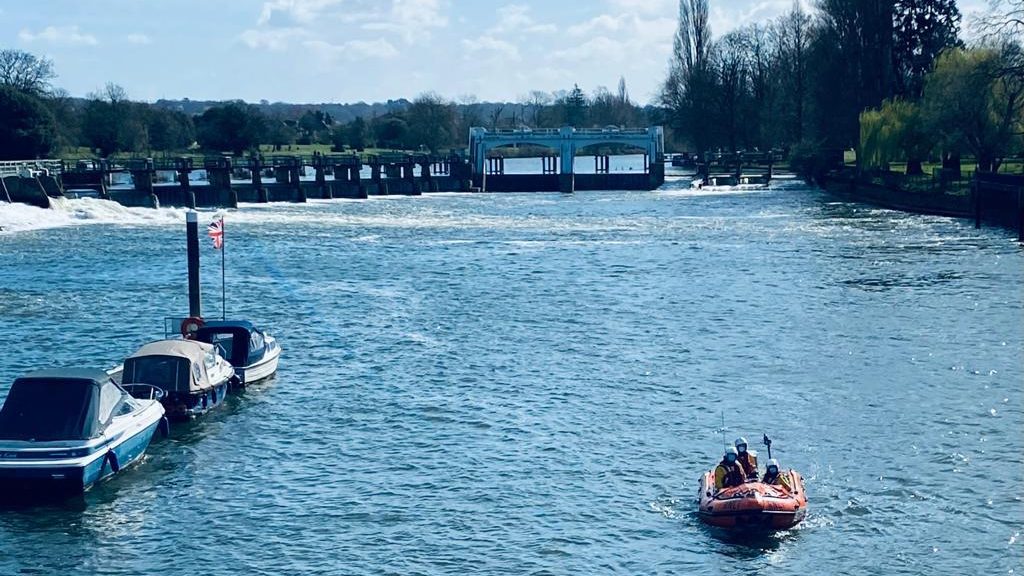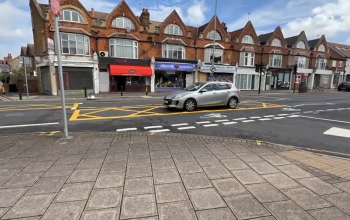Teddington lifeboat station is full to the brim with life-saving equipment. Fluorescent orange life jackets are stacked high and bright yellow boots line the walls. The station’s two lifeboats are just outside, poised for action.
In the central room where the boats usually live, about 40 people sit chatting and laughing as they wait for the weekly meeting to begin. They are all Royal National Lifeboat Institute (RNLI) volunteers, and have helped thousands of people between them.
As the meeting starts, silence falls. Everyone is laid back but attentive. Aside from some inside jokes, they are united, as they talk of lives saved and traumas undergone, by the underlying seriousness of their job.
The RNLI is responsible for keeping people safe on the Thames, which includes teaching them how to be cautious to prevent them getting in trouble in the first place. The Teddington station covers the area from Richmond to Hampton Court – with Kingston being its busiest area – so it has a lot of prevention to do. Its efforts are coordinated by the Water Safety team, led by Glenn Wouters.
As he and I look for a place to chat after the meeting, we pass the changing room where the volunteer life-savers prepare for shouts. The meticulous rows of suits and helmets, ready to be donned in lightning speed, are a sobering reminder of just how quickly things can turn nasty on the river.
Wouters first came into contact with the RNLI when he received a free membership while training as a scuba diver in the 1970s. During his years working as a commercial diver, he saw how crucial the service’s work was and felt compelled to do his bit to help.
Despite living in Teddington, he does not qualify to be an on-call lifesaver because he lives further than three minutes from the station, and the crew aims to be out on shouts – incidents where a lifeboat is deployed – within five minutes of getting the call. However, his work educating the public is invaluable in saving lives.
Finally settled next to the crew’s kitchen, he says that every shout prompts reflection. “Every time you see a lifeboat go out on a call, when we look at it from the RNLI’s perspective, if that lifeboat is going out on a shout, then we’ve got to ask ourselves in the prevention team – ‘what have we missed?’”
Safety in Kingston
Kingston is a particular problem area for the local service, largely due to the riverside where young people are especially troublesome.
Wouters said: “The young lads under the age of 24 come across as being Mr Invincible if they’re in groups. It’s that age group, the 18-24s. We’ve all been there, it just so happens that Kingston also has the nightclubs and the pubs right by the water. People can have a really good time, have a drink, lose their footing and they end up in the river.”
The proximity of the leisure venues to the water itself, with no barrier in some places, is also problematic. “We’ve worked with families who have had fatalities in Kingston, who have worked for many years in making the walkway by the river safer because they’ve had a loss,” Wouters says.
Restaurant owners, bar staff and bouncers have been equipped with throwbags – pieces of rescue equipment which, when thrown, give casualties a rope to cling on to so they don’t drift away – to use if anyone gets into trouble. Kingston Council has also helped fund first response training for locals to speed up reaction times to incidents on the riverside.
The water safety team is on a constant learning curve regarding how to enhance their services. “We have to understand the prevention and what we can do with the community to try and reduce the amount of people lost in water,” Wouters says.
“We can only do that with the community’s help, and that bounces back to water safety, awareness training, education – it’s a big revolving hamster wheel at the end of the day, and we’re trying to keep it going.”
Enlightenment is key
Using forethought and taking precautions are two of the central tenets of the water safety team’s work, as they are crucial in preventing tragedies from occurring. This is especially true of water sports, which really took off during the pandemic as complete novices took to the water to pass the time.
Wouters says: “Over the past few months, the influx of people who are paddleboarding has gone up [roughly] 200 per cent.” However, many are not proficient, and their lack of knowledge puts them at risk. Awareness of how to have fun safely is crucial.
A particularly prominent area of education is around cold water shock – a condition triggered on entry to water colder than 15⁰C; the Thames’ average temperature is 12°C. This form of shock is so rapid and severe that it leaves you vulnerable to drowning.
Wouters says it plays a part in many of the incidents the RNLI attends. “When people get cold very, very quickly, there is a physical change,” he says. “People lose the ability to swim because they get cold too quickly, they gasp for air, cold water shock kicks in within three minutes.” Especially at this time of year, avoiding entering the water is paramount.
If you fancy trying water sports on the Thames, the RNLI advises going onto the water with others if possible, or notifying someone where you are going and when so they can call for help if you do not return punctually. Other tips include wearing warm, waterproof clothing to prevent cold water shock, purchasing a suitable flotation device, taking your phone so you can call for help and getting the appropriate training so your experience can match your enthusiasm.
Wouters says that there is no such thing as being too careful. “It’s so easy to become a casualty or an incident because the red mist comes in. You think, ‘oh no, nothing will happen to me’, because you’re so keyed up to go out on the river that you forget about the safety angle. The advice is to only go out within your ability.
“You wouldn’t go cruising across to France when you’d only had a boat for a day.”
Protecting yourself
Despite warnings, accidents do happen. Knowing how to react in such circumstances can save lives, too. One of the RNLI’s biggest life-saving campaigns is Float to Live – the principle that if you fight your instinctual panic and relax when in the water, extending your arms and legs, you will float to the surface where you can breathe normally and wait for help. This has saved lives on multiple occasions.
Another instance where instincts must be fought is refraining from trying to be the “hero” and save casualties from the water. “We try and promote people not to enter the water,” Wouters says. “Make the call, keep your eye on the person in the water until emergency services come to you.
“The last thing we want is to have a casualty in the water, and then have a second casualty being someone who tried to save them.”
The RNLI spreads lessons like this as widely as possible, with information provided at training events, open days and school visits, as well as online. This messaging can cover abiding by riverside signs, using the right life jackets or seeking the correct help if something goes wrong.
Such communication with the public is key. “We have a responsibility and a yearning to make sure that the water safety message is getting out to a wider audience,” Wouters says.
He takes his position very seriously, but it is not a burden. “The RNLI gives me a level of education and understanding that I didn’t have before coming here. It gives me a sense of camaraderie. You’re not an individual here, you’re a body of people that is one big family,” he says. This calls to mind the jovial yet sincere mood of the team meeting. Mutual support is what gets the volunteers through the hardships of the job.
All of them share a common priority: “It makes me feel like what I’m doing is important to the community – I feel like what I’m giving is saving a life in the long-term.”
If you are in trouble on or near the river or see someone who is, call 999 and ask for the coastguard.





